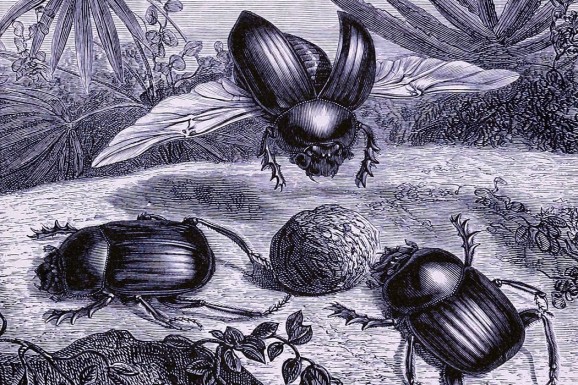Dung beetles. Most people have seen footage of them rolling their balls of dung across a field, like little loggers at a log rolling contest. The beetles use the dung either as a material where eggs can be laid or as food. The intricate movements that they use to roll the dung are incredible, but it’s equally amazing how far they roll their spherical cargo. Moreover, they always roll the dung balls in a straight line. How do they know where they’re going?
Turns out they use a navigation technique mariners in the days of sailing ships would have recognized: Dung beetles navigate using the stars. The beetles take mental “snapshots†of celestial positions. By comparing the positions of stars or other celestial bodies during each snapshot, they can keep themselves on course.
But what about during the day? Most insects, including the beetles, use the sun. Far from their nest, ants, for example, can orient themselves using the sun as a reference point. This even works when the sun is hidden by clouds. Just as a smart explorer brings a compass in case the GPS doesn’t work, ants have a backup plan. When the sun is hidden, ants can orient themselves using polarized light, or light that only vibrates in one plane. As sunlight passes through the atmosphere, it excites electrons in all directions. Some properties of the atmosphere cause light to polarize, or only excite electrons in one plane.
These atmospheric properties cause different degrees of polarization at different angles to the sun; if ants can detect polarization, they can detect the angle of the sun and use the sun to navigate even if the sun is invisible.
Not only can ants detect polarized light, their compound eye diverts polarized light and direct sunlight into completely different navigational systems. When both polarized and direct sunlight are present, the ants will rely first on the internal compass derived from polarized light. The one drawback is that ants have to learn their local sky first; drop them in an unfamiliar area and they will not be able to orient themselves. Ants who were raised with only a restricted view of the sky could navigate, but made many mistakes based on missing data. Many different insects, including bees, navigate in this manner.
Some of these navigation systems are incredibly sophisticated. Insects don’t have a lot going on in the brain department, but there’s enough capacity to remember the positions of celestial bodies or create detailed compasses based on the type of light available. It’s enough to makes you wonder what other kinds of intelligence exist in the animal kingdom that we just haven’t noticed yet.
Source: daily.jstor.org



